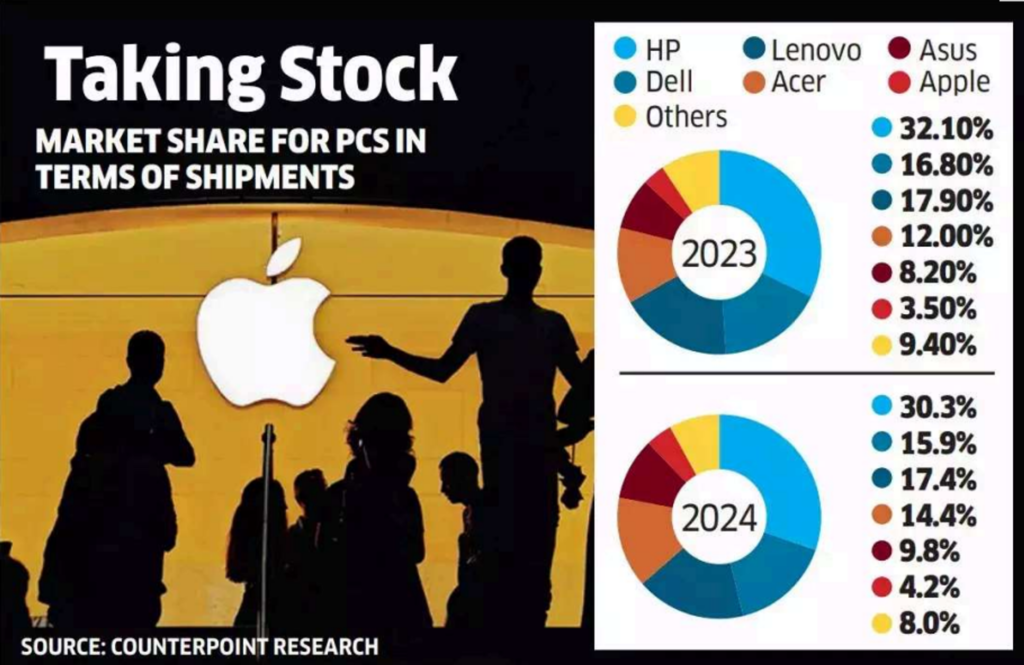It wants a bigger slice of India’s PC market

In this newsletter, we will talk about the the part of Apple’s plan to grow its business in India. Unlike most discussions regarding Apple’s growth plans, this one will not revolve around its iconic iPhones. The center stage for today’s discussion will be taken by what’s cooking at Apple (India) regarding its PC business.
A sidenote before we dive in, in case you missed our related newsletter dated June 12 2024, you can read the same by simply clicking the button below.
As usual, let’s start with a brief history of how the story of Apple Mac Book began.
Early Years
Picture this: it’s January 24, 1984, and Apple has just launched the Macintosh 128K, riding the wave of excitement from its iconic “1984” Super Bowl commercial. This computer was poised to revolutionize personal computing with its graphical user interface and mouse. However, despite the buzz, it struggled to capture the market’s attention. Why? It came with a hefty price tag of $2,495 but offered limited functionality. With only 128 KB of RAM, shared between the processor and display controller, the Mac was constantly bottlenecked, slowing it down by up to 35%. This setup left users frustrated, and initial sales fell flat, reaching only 70,000 units by May 1984, far short of Apple’s target of 1 Mn units in the first 3 months.
This clip from the movie Steve Jobs (2015) will gives you a good idea about it.

But the Macintosh found its niche among artists and designers, thanks to its graphical capabilities. Apple didn’t give up. They improved the Macintosh line with better memory and more powerful processors. The return of Steve Jobs and his collaboration with designer Jony Ive led to the creation of the iMac, revitalizing Apple’s fortunes with bold design and internet connectivity.
Fast forward to 2006, and Apple introduced the MacBook, designed to be both affordable and powerful with Intel Core Duo processors. It quickly became the best-selling Mac in Apple’s history. The MacBook continued to evolve, embracing innovations like Retina displays and Apple’s own M-series chips, making it a staple for people from all walks of life today around the world.

(Apple MacBook in 2006)
Now, let’s discuss a little bit about the journey of MacBook in India.
Journey in India
In 2006, Apple launched the MacBook in India alongside its global debut. Like many Apple products, the MacBook was seen as an aspirational item, and didn’t make a significant dent in sales.
Of course, at that time India wasn’t a primary focus for Apple, with its sights set on markets like the USA, Canada, Europe, Japan, and later, China. But things began to shift. In 2017, Apple started manufacturing entry-level products in India, signaling a new focus on the country. Then came a game-changer: the launch of Apple’s online store in India in September 2020. Before this, MacBooks were sold through authorized third-party resellers, retailers, and platforms like Amazon and Flipkart, which didn’t offer the customization options that Apple’s online store did. This newfound ability to tailor a MacBook to personal needs was a significant draw for Indian consumers.
But the story doesn’t end there. In November 2020, Apple made the bold move by ditching Intel processors in favour of its own, ushering in the era of Apple Silicon. The new M1 chips made MacBooks superfast and dramatically improved battery life, transforming them from a mere status symbols into some of the best-performing personal computers on the market.
The result? Apple’s strategic moves led to a more than 3x increase in MacBook sales in India.
Laptop Market in India
Let’s now diverge a bit from Apple and understand how the laptop market in India could be structured based on the end user. The laptop market in India can primarily be divided into the following THREE categories:

Growing Business and Niche Usage
Traditionally, Apple products have been the darlings of consumers, while Windows PCs reigned supreme in enterprises. Apple focused heavily on consumer markets, unlike competitors like Dell, Lenovo, and HP, which offered specific enterprise solutions. But change is afoot!
With the growing popularity of iPhones and iPads in business settings, Apple has shifted gears, embracing enterprise developers and partners to tap into this lucrative market. Recently, they even launched an India-specific ad campaign for Mac PCs, signaling a strategic push to capture enterprise interest.
Some companies are now wooing fresh talent by offering MacBooks, recognizing their appeal despite the premium pricing. If this trend catches on, it could significantly boost Apple’s market share in the coming years.
Currently, Apple holds a modest 4-6% share in the enterprise segment, but momentum is building. By December end, expectations are high that Apple will close in on a 7% market share.

(Source: ET)
To strengthen its foothold, Apple has teamed up with enterprises and educational institutions like Wipro, Zoho, SRM Institute of Technology, and Galgotias University, marking a significant shift in its approach. During the recent earnings call, Apple’s CFO, Luca Maestri, highlighted that Zoho offers its 15,000-plus employees a choice of devices, with 80% using iPhones for work and nearly two-thirds opting for Macs as their primary computers.
This growing acceptance in the enterprise and educational sectors is expected to drive remarkable growth for Mac PCs in India. By the end of 2024, Mac sales are projected to grow by more than 14%, bouncing back from a previous year decline. This surge could translate into a revenue of $1-1.2 Bn, a sharp increase from $600-700Mn from Mac PCs in India last year.
Projection and Future Focus
Recently, glitch with Microsoft Windows-powered computers have prompted many enterprises to rethink their IT strategies. Enter Apple, poised to capitalize on this shift despite its premium pricing.
Analysts predict that Apple is targeting large enterprises, aiming to break into Fortune 500 companies traditionally dominated by HP, Dell, and Lenovo. With Apple increasing its focus on enterprise MacBook sales, businesses diversifying their IT systems, and employees increasingly preferring MacBooks; its sales are expected to soar in India.
As a result, India’s importance as a key market for Apple will significantly increase. So, let’s see how this will unfold as Apple takes on incumbents dominating the Indian enterprise PC market.
✍🏻Author of this newsletter – Navid and Adnan
Fin Meme of the Week

Follow us
If you are a diligent investor, you would not want to miss checking out our research platform, where we share insightful research on companies regularly. Gain access to our sample research by clicking on the button below.




